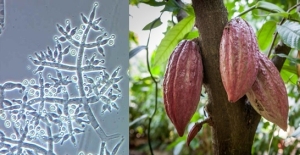Doutoranda: Miraine Kapeua Ndacnou. Data: 08/10/2019, às 16:00 horas no Anfiteatro do ESB. Orientador: Professor Robert Weingart Barreto.
The most devastating disease of Theobroma cacao in Africa is black pod (BP) – caused by oomycetes of the genus Phytophthora spp. – and the worst disease of this crop in Brazil is witches’ broom (WB) – caused by the basidiomycete Moniliophthora perniciosa. Yield losses can be up to 75% – 100% and have led to major socio-economical and environmental problems – particularly since cocoa is generally grown under the forest shade. Loss of cocoa often has been followed by widespread destruction of the native forests, as in the case of Southern Bahia after the arrival of WB from the Amazon. Control of the two diseases may involve the use of contact copper fungicides or systemic fungicides (metalaxyl and others). However, these fungicides are not routinely used in cacao farming because of high costs, practical difficulties of fungicide application and worries with contamination with pesticide residues. Biological control with antagonistic fungi has a recognized potential as a component of Integrated Pest Management (IPM) programs of cacao pathogens. Among the antagonists of BP and WB (as well as other cacao diseases) members of Trichoderma spp. have received the greatest attention. One example of a registered product available for use against WB and based on T. stromaticum exists in Brazil (TRICOVAB) and will be discussed, whereas experimental products based on T. asperellum have been developed in Africa agains BP with promising results. Favorable characters of fungi belonging to Trichoderma justify its choice as a ‘champion’ biocontrol agent and the great expections surrounding its exploration. Nevertheless challenges exist which need to be overcome for a broader use of Trichoderma as a disease management tool.
Key words: Black pod disease, witches’ broom disease, Phytophthora spp., M. perniciosa, Trichoderma spp., IPM.

